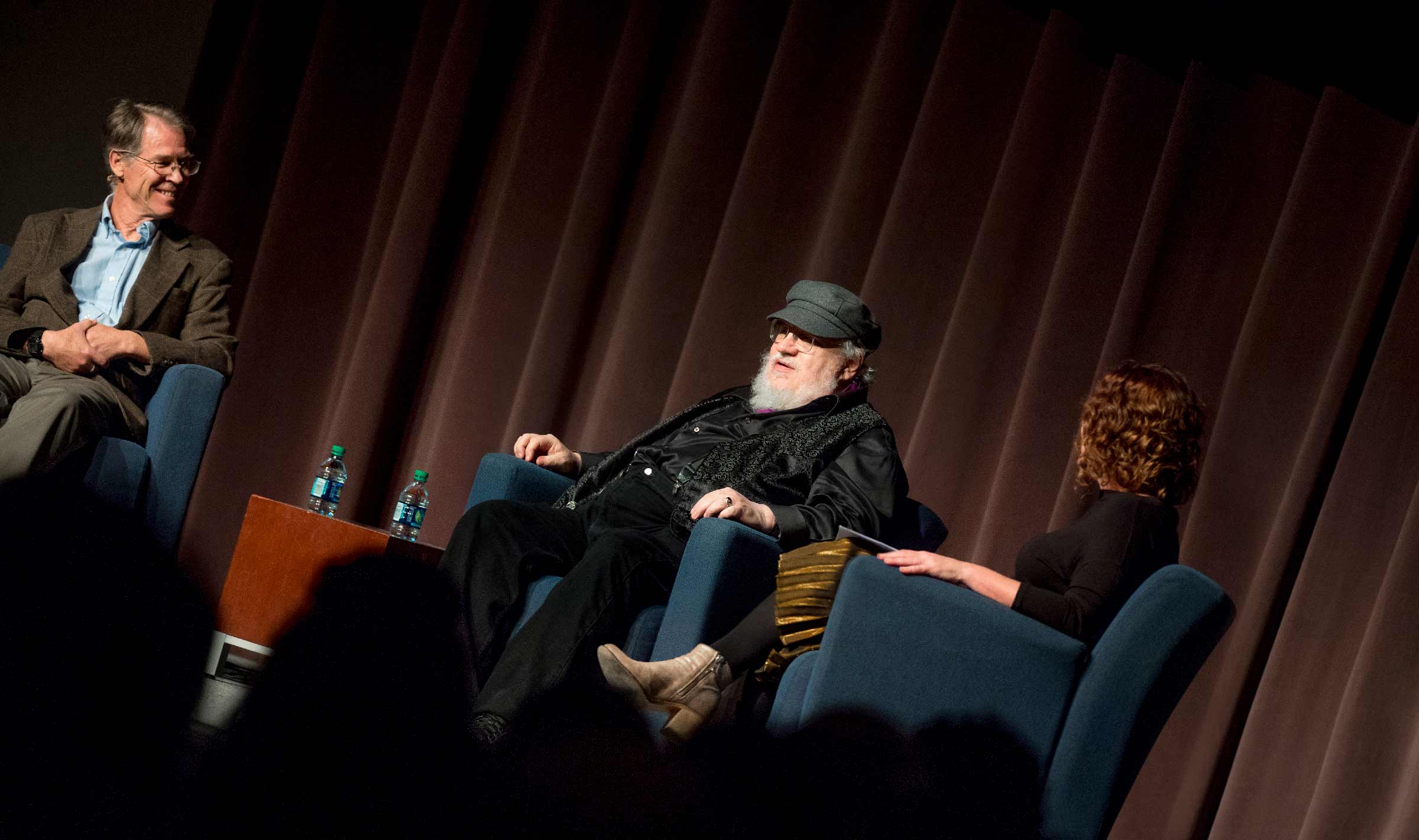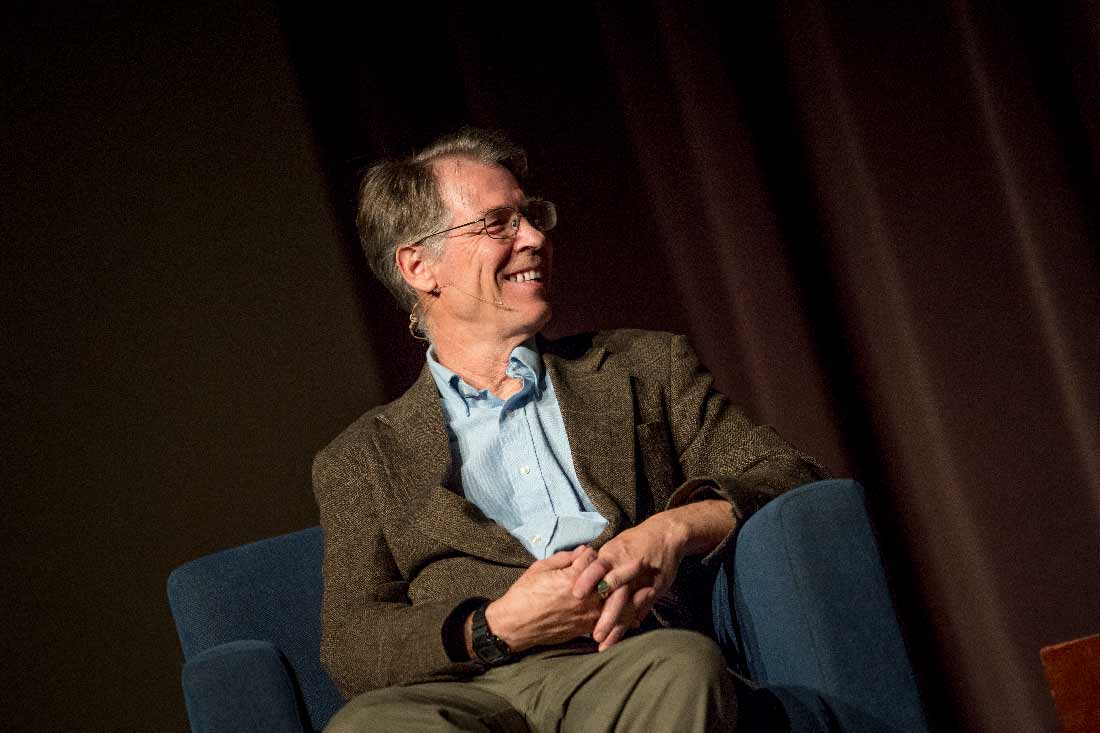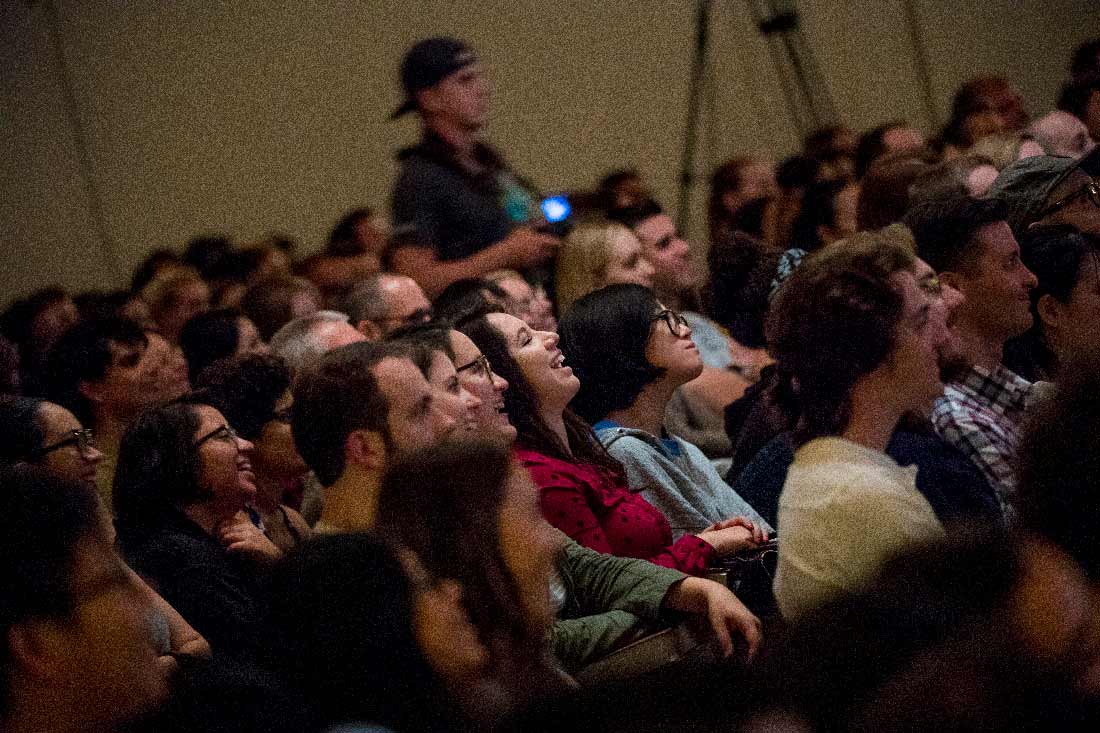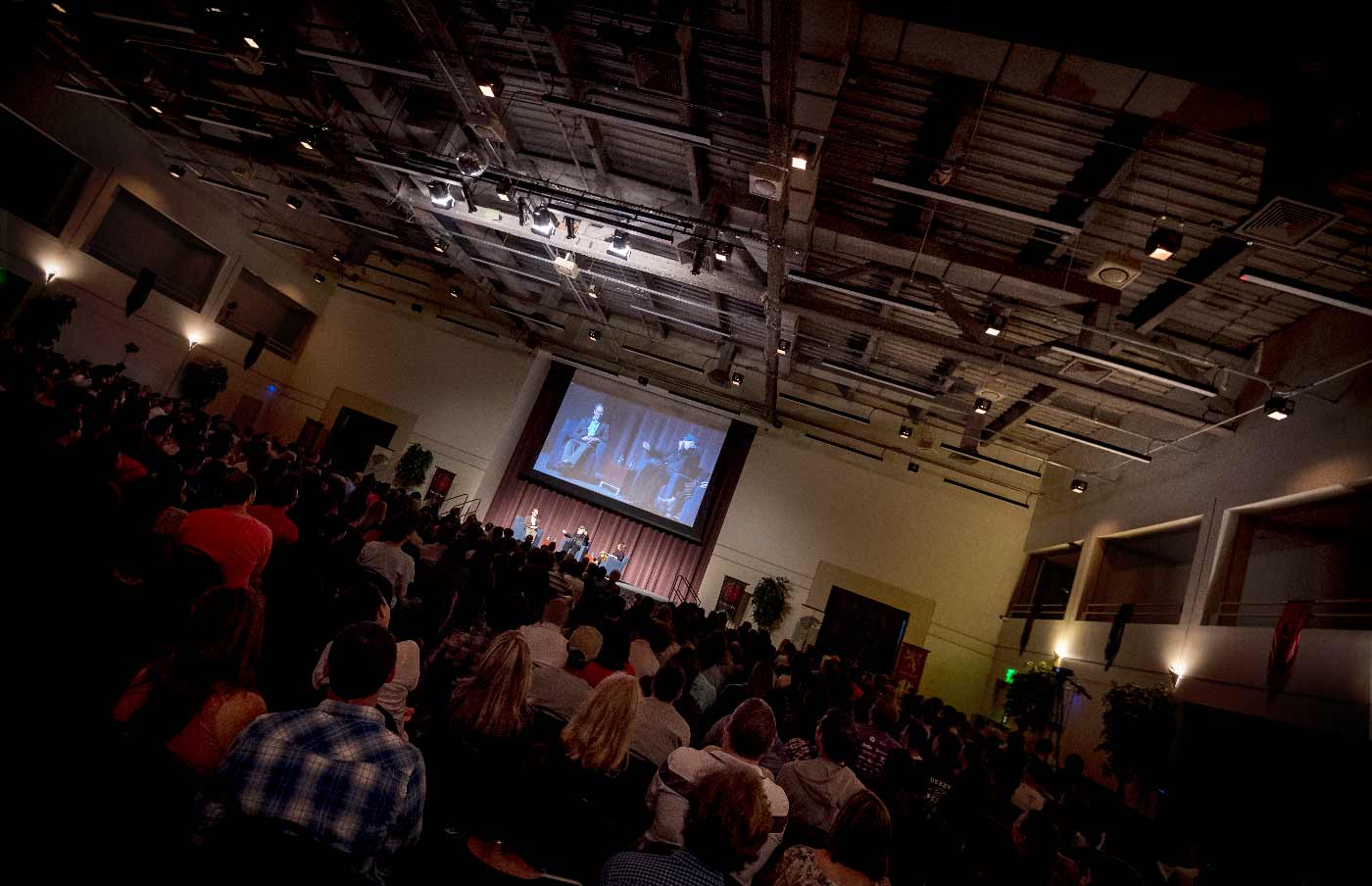By:
- Cynthia Dillon
Published Date
By:
- Cynthia Dillon
Share This:
Genre Giants
Famed authors humanize other-worldliness of science fiction and fantasy

Photos by Erik Jepsen/UC San Diego Publications
Science fiction and fantasy came to life in the real and human forms of authors George R.R. Martin and Kim Stanley Robinson May 2 at the Price Center West Ballroom. The genre giants, each with ties to UC San Diego through the Clarion Science Fiction and Fantasy Writers’ Workshop, bantered on stage under bright lights against a backdrop flanked by the emblems of the Great Houses featured in the “Game of Thrones,” HBO’s enormously popular adaptation of Martin’s “A Song of Ice and Fire” series. The novelists offered the large audience inspiring insights from their fantastic journeys through fiction—from Martin’s monster love to Robinson’s Martian romanticism. Topics they addressed included: the changes in science fiction and fantasy over time, the conceptual creation of each author’s alternative worlds, television and film adaptations of novels, and hierarchies of power. Drawing from their education, experience and expertise, they demonstrated why they are two of the most celebrated authors of our time.
Taking time away from their alternative worlds, the acclaimed novelists joined discussion moderator Shelley Streetby, professor of literature and ethnic studies at UC San Diego and director of the Clarion Workshop, to raise awareness and support for the world’s oldest writing program of its kind. Both men formerly served as Clarion Workshop instructors, and Robinson was a former Clarion graduate. He also is an alumnus of the UC San Diego Department of Literature.
In fact, Robinson attributed his introduction to science fiction to UC San Diego, which he described as extremely welcoming to science-fiction fans. He said he was especially influenced by new wave science fiction popular during the 1960s and 1970s. Later, Robinson played a prominent role in bringing the Clarion Workshop to campus in 2007. Among his genre influencers were Thomas Disch, Wyman Guin, Jack Vance, Ray Bradbury and H.G. Wells.

Considered the most prominent fantasy writer since J.R.R. Tolkien, Martin told the audience that his interest in the fantasy genre was sparked during his childhood when he read Andre Norton and Robert Heinlein stories, among others. He was also influenced by horror writers like Edgar Allen Poe and H.P. Lovecraft, admitting an early affinity for monsters. He shared that he was inspired by William Faulkner, particularly his unity-themed acceptance speech for the Nobel Prize. With both undergraduate and graduate degrees in journalism from Northwestern University, Martin began writing professionally full time in the late 1970s. He told the audience that he will be remembered for “Ice and Fire”/“Game of Thrones,” which he assured the crowd is not finished. In fact, according to the New York Times, HBO recently announced that it is developing a spinoff series based on Martin’s “vast and rich universe.”
When writing and creating their distinctive worlds, both Martin and Robinson said that they develop maps to follow. Martin, for example, said that he keeps the classic elements of fiction in mind and includes actual maps at the beginning of his fantasy books. “You must tell readers what the shire looks like so they can know what it looks like,” he said. “You must do some building in fantasy.”
Robinson, on the other hand, said that he uses large sheets of butcher paper and colored pens to literally map out his elements of story. He noted that one of the great joys of writing character-based fiction is that the stories are disguised memoirs. “It’s really about getting out of the way of other voices,” he said. “A novelist has to be the characters.”

Martin agreed, sharing that as he writes he gets into the frame of mind of his characters —essentially inhabits them—and his mood varies accordingly. “Some of the time I'm a dwarf, some of the time I am an incredibly hot chick riding dragons…The transition between character communities is difficult,” he admitted.
While discussing the history of science fiction and fantasy, Robinson, best known for his Mars trilogy, noted that the very first story we have is Gilgamesh—a reference to the “Epic of Gilgamesh,” an ancient Sumerian/Babylonian poem written in cuneiform script. It is considered the earliest surviving work of literature dating back to the third millennium BCE.
The two authors prompted audience laughter when in referencing domestic realism, Robinson commented that society is currently living a science fiction novel. “Science fiction is real and possible; fantasy is not,” Robinson stated. To which Martin replied, “There is more evidence of ghosts than of hyperspace.”
Streetby posed a question about high and low literature. Martin explained that high literature historically is what has been taught in school. It included writing by classic authors—in his genre individuals like Henry James and Robert Louis Stevenson. Low literature, however, included dime-story detective, romance, mystery, science fiction and fantasy books. He noted that there were more markets for science fiction than fantasy during the 1960s and 1970s. “Now the two sides are coming together,” he said.
Robinson agreed, noting that it is hard to tease-out the differences. “Time travel, for example, is science fiction but it is also fantasy,” he said. “And there is science fiction that allows you to drop into your dreams.”
“It’s magic,” agreed Martin.

Streetby noted that TV once was regarded as a lower form, but now it is artful. The authors concurred, with Martin adding, “This is the golden age of television. The quality of today’s television holds up to feature films.”
As for adapting literature to television and film, the two authors’ experiences differed. Martin has enjoyed great success, calling HBO’s adaptation of his books “magnificent.” Robinson on the other hand joked, “There have been six or seven options for ‘Red Mars,’ each more deadly than the last. Spike TV is now banned from doing science fiction.” Martin conceded that an author’s work is always going to lose something in the adaptation process.
Martin referenced J.R.R. Tolkien often throughout the discussion, but especially in discussing the theme of good versus evil. For example, he noted that the ring in Tolkien’s books represents power, and that power is evil to Tolkien. He also noted what he called the wonderful myth system in which a land prospered under a good king and withered under an evil king.
“When you get power, what do you do with it?” Martin asked rhetorically, explaining that his characters have to make such decisions.
And, ultimately, according to Martin, the battle between good and evil is waged in the individual human heart every day.
Share This:
You May Also Like
UC San Diego is Strengthening U.S. Semiconductor Innovation and Workforce Development
Technology & EngineeringStay in the Know
Keep up with all the latest from UC San Diego. Subscribe to the newsletter today.



